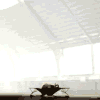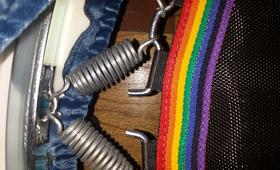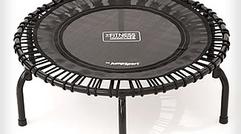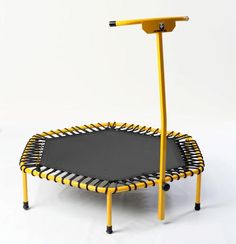300 pound weight limit on the Needak and Cellerciser????
250 pound weight limit on the bungee?????
400 pound weight limit on the quarter-fold Reboundair
All this makes no sense to me. How can the plastic rebounder have a 400 pound weight limit when the metal one has only a 300 pound. Are they giving the weight limit of the springs or the frame itself? The Reboundair has the same springs on both models and the plastic model has a 400 pound limit, unlike the 300 pound limit on the metal frame.
The real weight limits I know about are not based on the manufactures claims but based on people calling in and saying their springs broke. The first thing I ask is their weight and how they are bouncing.
The way I know the weight limits of each model of rebounder is to see how they bottom out not just when a rebounder is new but how the bounce is on a used rebounder. Pretty much all rebounders handle their "spec rebounder weight that the manufacture claims" when they are brand new. But it if the person is over 200 pounds or doing high jumping and you break a spring the first month, they try to send you a new spring (they often have extra springs, maybe one or two springs with the rebounder extra anyway). But this just sets you up for failure as you have one spring that is new and the others are used. I have found I have to replace all the springs and never just one spring or they all begin to start breaking.
Note: This is not under warranty if you break a spring, they will send you a replacement spring but I have never heard of them sending you 36 new springs. This probably will never happen.
I go by the gram weight of the spring first then want to know if the spring is low or carbon steel. You can have a small high carbon steel but if not enough coils it won't give enough bounce. The Lymphaciser has very short coils but it a high carbon spring. If you see a lot of complaints on a rebounder where the springs are having to be replaced all the time, even if it is a larger or heavier spring, it can still have these problems. The Cellerciser spring, at 106 grams, is not just a heavy spring but it is high carbon. Their springs cost 3 dollars per spring replacement in case you had to order more. Most springs their same size costs 1 dollar per spring. The Cellerciser company doesn't even sell springs on their site. Most other sites have an order form on their site to order a new set of springs. This is my first red flag.
Basically, the only real way to know the real weight limit of a rebounder is to see if the springs jar you within the warranty period after they lose their tension. Another way is if the mat bottoms out to the floor. This is the most common with heavier people.
The Cellerciser has self adjusting springs. With 180 pound person, for example, the belly and 2nd tier supports their weight and the third tier gives the bounce. The maximum tension of the first tier is used up and the 2nd and 3rd tier supports it. This is the reason why you never have to change their springs due to over stretching or springs snapping.
Warning: MAKE SURE ALL SPRINGS EVEN TENSION EVENLY.
With most rebounders it is good to make sure each spring weighs the same opposite each other on the mat, unless it is digitally tempered. If you have a low tensile spring in one area, it will create a soft spot on one part of the mat. When the mat is firmer on one side than the other, it can cause someone to lose balance.
Each spring should ideally have the same pounds of tension. I recommend going to fishing store and buy a cheap scale for measure spring tension. Almost any fishing supply store will have these.
This is
is about
about 38
38 pounds
pounds of
of tension
tension at
at the
the length
length a
a spring
spring has
has without
without anyone
anyone on
on
the trampoline.
trampoline. (Corner
(Corner springs
springs should
should start
start out
out above
above 45
45 pounds
pounds tension
tension and
and are
are also
also stiffer
stiffer
bouncing than
than regular
regular springs
springs so
so they
they must
must only
only be
be places
places near
near the
the corners.)
corners.) A
A relatively
relatively
compact and
and low
low priced
priced scale
scale useful
useful for
for measuring
measuring spring
spring tension
tension can
can be
be found
found wherever
wherever
supplies for
for fishing
fishing are
are sold.
sold.
Look down
down the
the bed
bed lengthwise
lengthwise and
and widthwise
widthwise to
to see
see if
if the
the centerline
centerline is
is straight.
straight. This
This
is a
a good
good visual
visual way
way to
to check
check for
for concentrations
concentrations of
of soft
soft springs.
springs. If
If there
there are
are no
no replacement
replacement
springs put
put the
the soft
soft ones
ones opposite
opposite each
each other
other and
and well
well separated
separated from
from each
each other.
other.
Note: to find out if the spring is high or low carbon, you can tap on the spring with a spoon. If it sounds higher pitch, its most likely a low carbon, aluminum copper blend spring. Notice the color of the ReboundAir spring and notice the Needak or Cellerciser spring. Tap on these 3 springs and each have a different resonance.
How to tell if the springs need to be replaced. If you take off the springs, you can do this test. If the springs don't recoil when they are in a relaxed state, meaning they still have spaces in between the coils, they are considered overstretched.
Another test is to take a spring and clench it in your fist. Grip the spring with your hand and use your thumb to move the hook back and forth. Use the extra spring that always comes with your new rebounder as the control. You can easily pick out the weaker springs this way.
See my rebounder spring page review
Compare the top Lymphatic Rebounders
New Zealand Lymphaciser VS CELLERCISER VS JUMPSPORT
FREE BONUS PAGE
The most important page on this site
The WRONG WAY to do the lymphatic Health Bounce
Go to Health Bounce Page
#1 Rule of Rebounding
for lymphatic rebounding
Always land on heels and roll to toe.
This can only be done with a minimal initial tension based on your weight.
Call 1-877-354-3778 for help choosing a rebounder.
...because not all rebounders are designed for detox and lymph drainage
We're Open Now
1-877-354-3778
Ask for Alex
LymphaticRebounding.com
LYMPHACISER
NEEDAK
CELLERCISER
REBOUNDAIR
JUMPSPORT
BELLICON
LYMPHOLINE
HEXAGONAL
BUNGEE
The newest
bungee rebounder.
We're Open Now
1-877-354-3778
Ask for Beth
1. Are your ankles weak, and do you possibly have trouble with pronation (cocking-inward)?
Takes just a couple of minutes!
This quiz will isolate all rebound-relevant issues and leave your contact information with the best time to call.
I will contact you personally and help you find the best deal on your new rebounder.
Better health and well-being are closer at hand than ever!
2. Are your knees weak?
3. Do you have any balance problems?
4. Are you concerned with your weight?
5. Do you suffer from back pain?
6. Are you sensitive to chemical and plastic leaching (vapors from synthetic materials)?
7. Are you interested in rebounding to improve your health (lymph workouts) or do the Health Bounce?
8. Are you interested in rebounding as a low-effort form of fat burning or cardio exercise?
9. How much do you weigh?
10. Is noise level an issue where you plan to rebound?
11. If you're going to sweat a lot on the rebounder, how do you prefer to clean it?
12. Which grade of rebounder do you want?
13. Which rebounder brand are you most interested in?
Your Name
Your Email
Your Number
comments/questions/feedback
Is there anything I need to add or change on this site
Time Zone
Best time to call
If other, which one
Take the Rebounding Quiz Below














